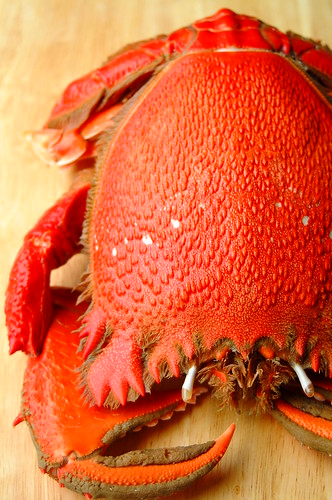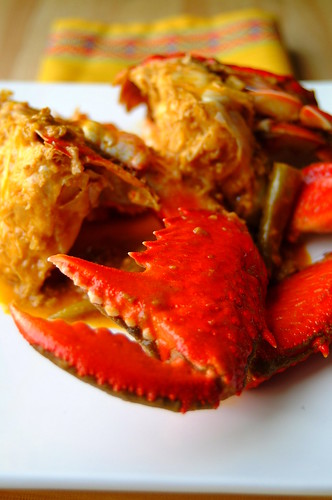
As I can see in the comments of my last post, a bunch of you already guessed that my crustacean visitor was a curacha from Zamboanga. It’s always a thrill to see such passion for local crustaceans. I’d love to give out prizes but I hope you will all be happy with a virtual-pat on the back for now…PAT-PAT :)
So yes, this not-so-little beauty is a curacha! (I have to point out here that many find this crab to be horrible-looking and scary, but that is a matter of perspective I think) It’s a very popular deep-sea crustacean found in the waters of Zamboanga, a province in the southern part of the Philippines, where spectacular seafood abound. It is likened to a cross between a crab and a lobster. Whether raw or cooked, it’s this brilliant reddish color. They say that curacha can only be found in the waters around Zamboanga, however, it seems that they are either the same as, or at least related to, the spanner crab or red frog crab that can be found in east and west coasts of Australia. Whatever the case, they are delicious and I am happy to share their provenance with my friendly Australian neighbors :)
I first tried curacha during a trip to Zamboanga in 2005 to visit my then-boyfriend’s (now-husband) hometown and, much to my surprise and delight, also to get engaged! Although the proposal was the highlight of the trip, the awesome seafood was also part of the wonderful experience that is Zamboanga. I am a big lover of crustaceans so I was eager to try the much-talked-about curacha and it did not disappoint. Unlike most crabs whose majority of meat can be found in their claws, the mother-load of the curacha’s meat is found in its body (although the claws also have meat). This one pictured here easily fed C and I to nirvanic fullness!
This fellow (and three of its siblings) arrived on our doorstep care of my father-in-law, who sent them from Zamboanga. He boils them fresh from the market over there, then freezes them and sends them to Manila. To say I was excited to receive them is an understatement. As I happily re-packed them in Ziploc bags (one in each gallon sized bag!), I already had the perfect way to prepare our first one. Another of C’s generous relatives gave us a kilo of Alavar sauce. A popular culinary highlight of Zamboanga, Alavar sauce is a deliciously secret blend of coconut milk and spices served and sold in Alavar Seafood Restaurant. Curacha with Alavar sauce is a dish not to be missed when visiting Zamboanga, a veritable institution really, so of course I had to prepare my first curacha this way.

Curacha con salsa Alavar*
- 1 large curacha, boiled until just done (do not overcook!)
- 500 grams Alavar sauce (approximate – depends on how sauce-y you want your dish…just a tip, the extra sauce is amazing on steaming hot rice!)
- 1-inch piece ginger, peeled and sliced
- 4 cloves garlic, roughly chopped
- 1 medium onion, chopped
- 1-2 pieces sili pangsigang (long green chili – other chilis can be used, just adjust to your own heat factor)
- Vegetable or canola oil
- Chop curacha in 2-4 pieces (first slice in half lengthways, then cracking it widthways is easy…which you can opt to do or not). Remove “lungs” (those weird finger-like things you also find in other crabs) and discard. Set crab pieces aside.
- Heat oil in a large wok or kawali. When oil is hot add garlic, onions, ginger, and chilis and sauté until onion is translucent.
- Add Alavar sauce and sauté for a few minutes until flavors meld and sauce is bubbling a bit.
- Add curacha pieces and toss until heated through.
- Serve immediately with hot steamed rice. Serves 2.
A few notes:
- I already had pre-boiled curacha, so this recipe reflects that. I’m sure it would be even better to cook the curacha directly in the sauce.
- Although Alavar sauce is delicious, I like to punch things up by adding extra spices and chilis.
- This is my first time to prepare this and I’m very open to suggestions!
If anyone out there makes it to Zamboanga, you must try this! Or if you have access to curacha and Alavar sauce in Manila (I hear they have a branch in Quezon city), make this dish post haste (although I’m sure if you have access to both then you already have made this)! The curacha’s body is filled with sweet and succulent meat. Just like the last time I had it, every time I poked my fingers in the shell more and more of the luxurious meat came out. It really is as good as all that. Aside from coconut milk and “secret spices”, Alavar sauce supposedly also contains crab fat. Now imagine that for a moment…crab in crab fat. Wait, it gets better (or worse, depending on perspective). As we are devouring this meal, C suddenly bursts out, “Omg! I think I found the aligue (crab fat)!” So make that crabfat found in the crab cooked in crabfat. There is only one place for that…on my rice!
I will leave you now to imagine what we looked like after this meal. Full to bursting, crab bits all over our hands, Alavar stains on our mouths, and a little bit incoherent. Not such a pretty sight let me tell you. Then again, that’s a matter of perspective.
*This is not Spanish. It's Chavacano, Zamboanga’s native dialect :)